April 10, 2009
Air Date: April 10, 2009
FULL SHOW
SEGMENTS
Following the Paper Trail
View the page for this story
The paper industry is profiting from an obscure law intended to reduce dependency on fossil fuels. Only to qualify for the tax credit, they are using more fuel; they could gain as much as eight billion dollars from the government by doing so. Living on Earth Host Steve Curwood turns to The Nation magazine's DC editor, Christopher Hayes, to lead him through the paper trail. (06:00)
Gassing Up
/ Jeff YoungView the page for this story
The Natural Gas industry says their home-produced product could help the country cut its CO2 emissions and oil imports. The fuel is cleaner than coal and newly discovered deposits here in the U.S. promise more supply and lower cost. But so far the Obama Administration is taking a pass on gas. Living on Earth’s Jeff Young reports from Washington. (06:00)
On Thin Ice
View the page for this story
Representatives of more than 60 nations and international organizations are meeting in Baltimore to discuss the state of Earth's melting polar regions. Living on Earth host Steve Curwood talks with Chuck Kennicutt, president of the Scientific Committee on Antarctic Research, about some of the science that's driving the discussions-- from warming ocean currents to the struggles of Emperor penguins. (06:10)
Alaska’s Changing Climate
/ Gabriel SpitzerView the page for this story
Gabriel Spitzer’s report from Shishmaref continues, as a storm blows in and causes more erosion. Host Steve Curwood talks with Bruce Eningowuk, a resident of Shishmaref, about conditions on the island today, and the plans for relocation. (08:30)
Forecasting A Warmer World
View the page for this story
Predicting the changes that could accompany rising global temperatures isn't all guesswork. Author Stephan Faris found plenty of examples of the consequences of climate change all over the world - from the quality of wine to ethnic cleansing in Darfur. He talks with Living on Earth host Steve Curwood about what the future might hold and about his new book, Forecast. (06:10)
Spring Awakening
/ Rick BassView the page for this story
Melting snow and playful grizzly bears are some of the simple joys Montana writer Rick Bass enjoys as winter turns to spring. (02:20)
Show Credits and Funders
Show Transcript
Host: Steve Curwood
Guests: Brice Eningowuk, Stephen Faris, Christopher Hayes, Chuck Kennicutt,
Reporters: Rick Bass, Gabriel Spitzer, Jeff Young
[THEME]
CURWOOD: From Public Radio International – this is Living on Earth.
[THEME]
CURWOOD: I’m Steve Curwood.
Creative use of a renewable energy tax credit increases pollution -
HAYES: The spokesperson for International Paper - when I said to her – “Well isn’t it a little weird, don’t you think, that you are adding diesel fuel to obtain a tax credit designed to incentivize the reduction of fossil fuels?” and she said, quote, “It is what it is.”
CURWOOD: And what it is - potentially - is billions of dollars for the paper industry. Also natural gas is bubbling up in the debate over how to lower greenhouse gas emissions. And a new book chronicles some unforeseen effects of a warming world.
FARIS: To me, wine was a fascinating example of how climate change is playing out. One, because it’s a crop that’s so sensitive to temperature, and secondly, because it’s an example of how climate change is gonna impact even things you might not expect, like a luxury good.
CURWOOD: We’ll have those stories - and more - this week on Living on Earth, so stick around!
Following the Paper Trail
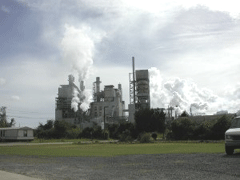
International Paper Company’s kraft process pulp and paper mill in Georgetown, South Carolina.
[NEWSBREAK MUSIC: Boards Of Canada “Zoetrope” from “In A Beautiful Place Out In The Country” (Warp Records 2000)]
ANNOUNCER: Support for Living on Earth comes from the National Science Foundation and Stonyfield Farm.
[THEME]
CURWOOD: From the Jennifer and Ted Stanley Studios in Somerville, Massachusetts - this is Living on Earth. I’m Steve Curwood.
This time of year many people are still looking for last minute ways to cut their tax bill. But any deduction typical citizens can come up with is probably pocket change compared with the tax bonanza paper companies have discovered. They are cashing in on a tax credit intended to reduce fossil fuel use by using… more fossil fuels!
Acting on a tip from a hedge fund friend, Christopher Hayes followed the paper trail. He’s the Washington editor of The Nation, and he joins me now from the capital.
Chris, welcome to Living on Earth!
HAYES: Thanks for having me.
CURWOOD: So, as I understand it, we could pay paper companies as much as eight billion this year from the public treasury to use more fossil fuel? I mean how did this happen?
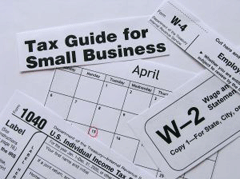
The paper industry gets a big boost this tax season—and not just from millions of print-outs of tax forms.
Well, along comes the paper industry. The paper industry has this distinct way of producing paper, it’s called the Craft process. It’s actually kind of a neat, closed loop. And what they do is they separate out the wood chips, they separate out the material that’s gonna be made to turn into pulp and paper, and the rest of the material is left in this water, it’s called black liquor, which is a great evocative name, and it’s full of a lot of carbon particulate, and so it burns. And they use that black liquor as the fuel that powers the rest of the industrial process to turn the pulp into paper.
CURWOOD: Wait a second, Chris, this is a renewable fuel. I mean if it’s coming from trees, they grow back again, this is a good thing already.
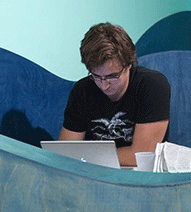
Christopher Hayes (Photo: Lindsay Gallup, TimeOutChicago)
Well, they churn through so much of this stuff, the numbers, the amount of money they’re getting from the government, is extraordinary. You know, eight billion is one sixth of the total amount of money we spend on foreign relations and foreign policy. It’s about one quarter of what it costs to insure the uninsured. I mean, it is a tremendous amount of money. International Paper, which is one of the largest paper companies in the world, announced on March 25th that for one month of running fifteen of their plants with this new mixed fuel, they got a $71 million check from the United States government. Now keep in mind, this is a company that lost $450 million in the last quarter of ’08. So, the money to be made by gaining this tax loophole is far far greater than the money to be made in actually producing paper.
CURWOOD: Now, you’ve talked to some paper industry folks, what do they have to say about this deal?
HAYES: Frankly, I think the paper industry is hurting right now. And I think they’re grabbing at any lifeline they can get. I don’t think they’re going to be particularly apologetic on their end for manipulating a tax credit in a fully legal way to increase the profits for their company.
CURWOOD: They don’t feel like they are kind of, you know, [SNORTS] snorting at the trough here?
HAYES: Well, I mean, maybe they do if you got a few drinks in them [LAUGHS] and they weren’t talking to a reporter on the record. I mean, the spokesperson for International Paper, when I said to her, “Well, isn’t it a little weird, don’t you think, that you’re adding diesel fuel to obtain a tax credit designed to incentivize the reduction of fossil fuel?” And she said, quote, “It is what it is.”
CURWOOD: The writers of the bill can’t be very happy. I can’t imagine that everyone on Capitol Hill is happy about this either. Who, if anyone, is taking action?
HAYES: So, there is a widespread consensus that this is absolutely a perversion of the law’s intent. And the day after my story came out, the government relations office of the paper industry trade group sent out a very panicked memo to their members saying that they had heard that Senators Baucus and Grassley, who are the chair and ranking member of the finance committee, are considering closing off the loop hole and that paper companies should consider contacting their senators and put their shoulder to the wheel to try to keep it in place.
CURWOOD: What does the White House say about this?
HAYES: The White House had no comment on it. They referred me to Treasury. Treasury has been inundated and difficult to get a comment out of.
CURWOOD: Well, we tried the White House asking about your story, so far we haven’t had any luck either.

International Paper Company’s kraft process pulp and paper mill, located in Georgetown, South Carolina, one of the largest of its type in the world.
CURWOOD: Chris Hayes is the Washington editor of The Nation who wrote “Pulp Non-Fiction.” Well Chris, do you have an alternative for the use of paper at your office? You may have trouble getting supplies now.
HAYES: [LAUGHS] I know. Well, you know, the funny thing is that as a paper magazine, we’ve been around since just after the end of the Civil War, lower paper prices probably indirectly help us. So I may have been biting the hand that proverbially feeds me a little bit. But, in my own personal life, I have a rule, which is that I don’t write things down on paper unless I want to forget them.
CURWOOD: Chris Hayes, the Washington editor of The Nation. Thank you.
HAYES: Thank you.
Related links:
- Check out Christopher Hayes's muckraking article here.
- Click here to read International Paper’s March 24, 2009 statement about the receipt of its check from the IRS for $71.6 million.
Gassing Up

Natural gas is taking heat in the energy debate.
CURWOOD: And now from diesel to natural gas.
As Congress considers sweeping changes to our energy system, natural gas suppliers are hoping to win a bigger piece of the pie. Citing newly found sources of gas, they trumpet its low carbon potential for transportation, and say it’s a cleaner alternative to high carbon coal for generating power.
But others say not so fast. Living on Earth’s Jeff Young reports.
YOUNG: This August marks 150 years since the birth of the American oil and gas industry. It all started in Pennsylvania, near the town of Titusville, a fellow named Edwin Drake drilled down seventy feet for the first commercially successful oil well.
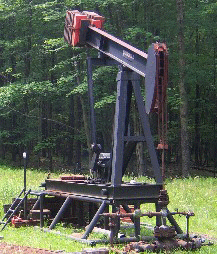
Drilling for natural gas in the Marcellus Shale. (Photo Kirk Johnson, Courtesy of the Sierra Club)
PICKENS: We are overwhelmed with natural gas. What a chance. What a chance for America to fix a critical problem.
YOUNG: Pickens was in Washington this month for the introduction of a bill by Oklahoma Democratic Representative Dan Bourne. It combines tax breaks and government purchases to expand the fleet of heavy duty vehicles powered by natural gas.
PICKENS: The only thing we’ve got, the only resource we have in America to really reduce dependency on foreign oil, you’ve got to go to natural gas. It is cleaner. It’s cheaper. It’s ours, and it’s abundant. What a wonderful solution to a very difficult problem.
YOUNG: Pickens and his allies on Capitol Hill hope the Obama administration will get on board. Obama’s chief of staff, Rahm Emanuel, introduced a similar natural gas bill when he was in Congress. But Obama’s energy secretary, Steven Chu, is not yet a believer.
CHU: You know, I’m agnostic, really, about it. The other stakeholders developed the biofuels using agricultural lumber wastes and plants specifically designed for growing energy. I don’t know which one will win. I think we could look at both. But remember, if we significantly shift our use in transportation to use of natural gas that will put a strain on natural gas for industrial uses, for heating and other things. So, it’s a complicated issue.

T. Boone Pickens has called for increased natural gas usage to ease the transition to wind energy. (Courtesy of T. Boone Pickens)
BOUCHER: Natural gas prices would spike. 58 percent of American homes are heated with natural gas. And we would see Americans across the board put to deep economic pain. Much of American industry is natural gas dependent. We would see broad economic disruption because of that flight to natural gas. We simply must avoid that.
YOUNG: As a key player in the House Energy Committee, Boucher is shaping the climate bill that committee’s working on. But gas industry experts say Boucher’s fears are a bit dated. Rick Smead is with Navigant Consulting, and the American Clean Skies Foundation, a natural gas lobby group.
SMEAD: Fuel switching to natural gas would be the most effective, lowest cost answer to the carbon impact of coal. It’s an asset that’s being overlooked in the policy debate.
YOUNG: Industry analysts say prices would rise some, but the newly abundant supply means big price spikes are unlikely. The country already has a lot of power plants built to burn natural gas that mostly sit idle because coal is cheaper. Simply firing them up more often could shift the country’s mix of fuels for electricity by ten percent or more. And Smead happily points out that gas has fewer problems than other air pollutants.
SMEAD: I always tell people that if they don’t believe that they should just go burn some coal in their kitchen next to their gas stove.

ARNOWITT: They actually had enough gas in their water that there was an explosion from the well. Not what you expect to get when you turn on the faucet.
YOUNG: It was an isolated incident, but exploding water tends to get people’s attention. And Arnowitt says the hydraulic fracturing, or fracking technique that drillers now use raises other water issues at the surface.
ARNOWITT: They need millions of gallons per well. Some streams were literally sucked dry. Our bigger concern is around what to do with all the wastewater, how is that going to be treated. There’s a whole range of contaminants in drilling wastewater. So our concern is that as drilling progresses, that we have the proper protections in place that this kind of thing doesn’t happen.
YOUNG: Drilling businesses say they’re working on safer ways to use surface water and minimize impact on water underground. The industry is well aware that state regulation will have a big effect on how much gas companies can afford to bring out of the ground, which means in this anniversary year for the petroleum business, Pennsylvania could once again be the place where the industry’s history is written.
For Living on Earth, I’m Jeff Young in Washington.
Related links:
- To read an industry study on new supply of natural gas, click here.
- A citizen’s group raises questions about the environmental impact of gas drilling in Marcellus shale.
[MUSIC: Horacio El Negro Hernandez and Robbie Ameen “Hit This, Split This (Producers Mix) from El Negro And Robbie at the Third World War (American Clave 2004)]
[MUSIC: Sol Y Canto “Como Volar” from Cada Dia Un Regalo (Music Amador 2009)]
CURWOOD: Just ahead –Native Alaskans awash in the sea change of climate. Keep listening to Living on Earth!
On Thin Ice
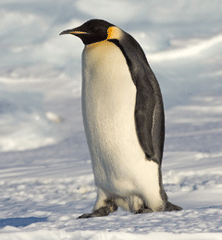
Warming ocean currents could force Emperor penguins to swim farther for food. (Photo: Samuel Blanc)
CURWOOD: It’s Living on Earth, I’m Steve Curwood.
The latest round of talks leading up to an updated UN climate change treaty wound up April 8 in Bonn, Germany with the US pledging to work hard in the effort to reach consensus by year’s end in Copenhagen. And even as delegates met, an ice bridge gave way in Antarctica, the tenth such major ice collapse in recent times. US Secretary of State Hillary Clinton was quick to link the climate talks to the agenda of the first ever meeting of the Arctic Council and Antarctic Treaty nations that she hosted in Baltimore.
CLINTON: Climate change is shaping the future of our planet in ways we are still striving to understand. And with the collapse of an ice bridge that holds in place the Wilkins Ice Shelf, we are reminded that global warming has already had enormous effects on our planet, and we have no time to lose in tackling this crisis.
CURWOOD: Chuck Kennicutt is president of the Scientific Committee on Antarctic Research, a professor of oceanography at Texas A&M University, and a delegate to the polar conference.
Professor Kennicutt, what can you tell us about the science that’s on the agenda?
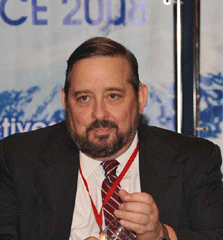
Professor Chuck Kennicutt.
CURWOOD: Talk to me about the West Antarctic Ice Sheet, we’re told that forecasts say that if this ice sheet, which I gather is kind of hard aground, if it were to melt enough, or the stuff underneath it were to melt enough and it were to slide into the ocean, this would raise sea level around the planet. Are we getting data that there are changes happening there?
KENNICUTT: Yes, in fact, that’s one of the big unknowns, contrasting what is occurring in the north with what’s occurring in the south. In the north, because sea ice is already floating, that means that it’s already part of the current sea level. In the south, though, most of the ice is grounded, it’s actually sitting up on land, it’s not in the ocean. And so as that ice melts, though, that actually raises sea level, which raises the level worldwide. That’s why it’s a worldwide impact.
CURWOOD: How much sea level rise are we talking about?
KENNICUTT: Well, West Antarctica could be as much as sixty feet of sea level, which is really quite spectacular. But, that’s if everything melted, and that’s very unlikely. Just so people understand, an ice shelf is the seaward extension of an ice sheet. And the ice sheet being grounded on land where it’s actually sitting on a solid rock base, whereas the ice shelf actually flows out over a bay. So it’s floating ice. Probably the greatest concern, though, is that the disintegration of these ice shelves then allow the ice sheets to move even faster. In other words, the seaward extension of the ice was actually holding back the land based ice. And this has come from actual observations, because a number of these ice shelves have disintegrated over the last ten years or so.
CURWOOD: You say that some of the recent research presented at your meeting talks about the changing ocean currents. How are they changing and how important is this?
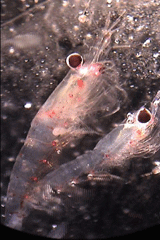
Krill are key to the Antarctic ecosystem.(Photo: NOAA)
CURWOOD: Now, we also hear that some of the ecosystems there are under stress. I gather there’s been some talk at this conference about the change in the amount of krill – the Antarctic krill – in the region. What do we know about that?
KENNICUTT: Now many polar organisms, including krill, because they’ve evolved in these types of environments, their lifecycles are tied very closely to the presence or absence of ice. Now the krill, particularly in the southern ocean system, is what’s referred to as a keystone species. That means it’s very critical to the overall food web. So penguins feed extensively on krill, the whales feed on krill – so you have a ripple effect.
CURWOOD: What about the Emperor penguins? A lot of people know about them after the famous movie.
KENNICUTTT: Yes. There was an interesting study just lately that again showed that the current warming was having rather dramatic effects on their habitat and started to raise questions of in the next several decades if they are not going to start to have some detrimental effects due to loss of habitat. And again, this is loss of ice and loss of food stuffs.
CURWOOD: In other words, the penguins could march all the way back to the sea to get fed, but there wouldn’t be anything to eat?
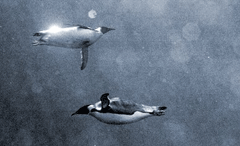
Warming ocean currents could force Emperor penguins to swim farther for food. (Photo: Samuel Blanc)
CURWOOD: Chuck Kennicutt is the president of the Scientific Committee on Antarctic Research, and a professor at Texas A&M. Thank you so much, Professor.
KENNICUTT: Okay, appreciate it.
Related links:
- Check out the scientific collaborations of International Polar Year
- Learn more about how global warming is impacting the Polar regions
- For more on Chuck Kennicutt, click here
- Link to the Scientific Committee on Antarctic Research’s website
[MUSIC: Banco De Gaia “Echoes” from Backspin: A Six Degrees 10 Year Anniversary Project (Six Degrees Records 2007)]
Alaska’s Changing Climate
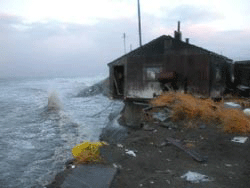
The ocean takes a 25-foot deep bite out of Shishmaref’s west end. (Photo: Gabriel Spitzer)
CURWOOD: Compared to the relatively gradual pace of warming in the Antarctic, the Arctic is warming rapidly - faster than any other place on earth.
As part of our observance of Earth Day this month, we revisit some memorable stories from the Living on Earth archives, and check out what’s happened since. Today – a report from 20 miles south of the Arctic Circle – Shishmaref on Alaska’s north-west coast. Inupiat families have lived in the region for at least a thousand years – but visitors can only get in by boat or small plane. Both the Native Alaskan way of life, and Shishmaref itself are now threatened. And now no ice protects the island from erosion caused by fall storms and vicious waves.
Reporter Gabriel Spitzer visited the island community in 2004.
SPITZER: Tony Weyiouanna is loading up his boat, a rickety, plywood tub powered by a potent 115 horsepower outboard motor.
[MOTOR STARTS UP]
WEYIOUANNA: We got about 18 miles to go, but we gotta cross the bay first. But I gotta go this way then I'll shoot back up that way.
[MOTOR CRANKS INTO GEAR]
SPITZER: Tony is heading across the inlet with his wife Fannie and eight-year-old son Clarence, on the hunt for something to eat.
WEYIOUANNA: I'm hoping we'll see a caribou today!
SPITZER: He picks his way across the shallow inlet, using a route honed by scores of generations through the channels and underwater obstacles. He skirts sandbars that lurk just a foot or two below the surface. Clarence is the first to spot the antenna of a sunken boat poking out of the waves.
On the other side, Tony pilots his boat up a small river to his hunting camp, near several of the sites Shishmaref is considering for a new village.
[CABIN SOUNDS]
SPITZER: Inside his cabin, Tony marvels at being out on the water today at all. Near the Arctic Circle everything freezes solid in the fall and stays that way for as long as six months. But now, the late freeze-up has become almost routine. Tony has bright eyes and often finishes sentences with a sly, "I jokes." But his face darkens a little as talks about it. It reminds him of old stories from the elders.
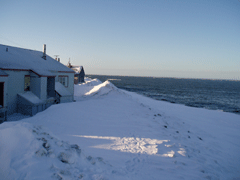
This photo was taken on February 16, 2006. It shows open water in front of
Shishmaref’s teacher housing. The lagoon froze over but the ocean did not.
SPITZER: Though Tony, Fannie and Clarence are hunting caribou on land today, the people of Shishmaref mainly look to the ocean for sustenance. That's where they find seals, walrus and oogruk, or bearded seal.
Harvesting, preparing and preserving ocean-caught food are what bind this community together. It's more than just survival: it's relationships and a link with their ancestors.
Moving farther from the ocean or dispersing into surrounding communities could upend that lifestyle. It makes people here nervous.
WEYIOUANNA: I guess you could say I'm a little bit worried about what kind of effect it'll have on our way of life, you know? It's gonna make it harder for us to access the coast.
SPITZER: For people here, every bend in the river has a name.
[RIVER BOAT SOUNDS]
SPITZER: And so it's with a sure hand that Tony turns his boat upriver, stopping periodically to scan the tundra. The searches are fruitless, and in the dimming light Tony decides to turn back.
Then, in an instant, the speeding boat slows to a crawl. Tony stands up and sets his rifle, while his wife and son tense in anticipation.
[GUN BLAST]
CLARENCE: Dad shot one!
[GUN BLAST, SCRAMBLE OUT OF BOAT]
SPITZER: Clarence leaps ashore to investigate his father's kill. Perhaps 75 yards away, a gray form lies sprawled on the lichens.
CLARENCE: (Tromping across tundra) Caribou! (breathless) ... Caribooooou! (yells)
SPITZER: Clarence sprints across the tundra, his red Harley Davidson cap flopping in the wind. Tony wastes no time.
[SOUND OF SLICING KILL]
SPITZER: He sinks to his knees and begins to skin the caribou.
CLARENCE: OK, Ma, are you trying to tear off the skin or what?
FANNIE: Yep. Now I'm just holding the skin for your dad.
CLARENCE: OK, Dad, you gonna take out the stomach?
WEYIOUANNA: Yep. Thanks for reminding me. (LAUGHS).
SPITZER: Tony opens its belly and picks among the organs, saving some and discarding others.
[SOUND OF SLICING]
SPITZER: Shishmaref people know exactly where and when to harvest the animals and plants that feed them, and how much can be taken each year.
[BOAT SOUNDS]
SPITZER: They drag the animal to the boat, and head back to the village that's slowly flaking off into the ocean.
[MOTOR SOUNDS, THEN VILLAGE DOGS BARKING ON LAND]
SPITZER: Back on the island, teams of huskies bark restlessly in the midday sun, tethered to squat wooden dog houses. Teenagers speed by in ATVs, over dunes covered in yellowing beach grass.
[MOTOR SOUNDS]
SPITZER: The people here remember the parts of their island that have plunged into the waves: the long beach, the two rows of sand dunes, the children's playground. Shishmaref has already lost one home, and 18 more have been moved away from the bluffs.
Elder Morris Kiyutelluk remembers when it was his turn to move.
KIYUTELLUK: Well, it came suddenly, it was ... we got that storm. And during the night they said, well, we gotta move your house. And all the people got together, and I couldn't control 'em really, they just started going inside my house and taking everything out. Wrapped two big rope around it and them got together and just dragged it across the ground. [LAUGHS] That was the first time I've seen erosion that fast.
SPITZER: About 500 miles away, scientists at the University of Alaska Fairbanks are trying to figure out what's happening to the village and others like it.
SPITZER: John Walsh, director of the University's Center for Global Change, pulls up a graphic showing a new 500 mile swath of open water between the sea ice and the coast.

Climate change has melted the permafrost in Shishmaref. The land is now softer and more vulnerable to erosion. Notice the placement of the trashcan before the storm.(Courtesy of NOAA)
SPITZER: That sea ice used to protect coastal villages from the battering waves that storms bring each fall. Now that freeze-up doesn't happen until later, they're exposed to erosion during storm season.

After the storm the trashcan is much closer to the shore. (Courtesy of NOAA)
SPITZER: The reason the arctic is warming so much more quickly than the rest of the world has to do with something called the Albedo effect.
WALSH: When the sea ice and snow retreat, they're revealing a much darker surface underneath. And the darker surfaces are much more effective at warming in response to incoming radiation. And then this enhanced warming will in turn contribute to a greater retreat of the sea ice and the snow cover. So you have a feedback loop.
SPITZER: Arctic warming triggers other feedbacks as well, like melting permafrost. The permanently frozen ground stores huge quantities of carbon and trace greenhouse gases. As it thaws, the carbon is released into the atmosphere and amplifies the warming.
Ecology Professor, Terry Chapin.
CHAPIN: Most of the effects on Arctic warming originate from activities that occur outside the Arctic. So it's people burning fossil fuels, changing patterns of land use. The biggest disconnect is that the impacts that are occurring in the Arctic are not widely appreciated by people that don't live here.
[WEYIOUANNA TOURING AREA]
WEYIOUANNA: Didn't realize it collapsed this far. You can see along here the permafrost eroded, so all this ground just collapsed, see?
SPITZER: Tony Weyiouanna is taking a look at what's changed since the last time he toured Shishmaref's coast. In front of the bluffs sit crumbled piles of sand. Further out into the shallows, the remnants of several failed seawalls are decaying.
Shishmaref is made entirely of fine sand and permafrost. As the waves erode the bluffs, the permafrost emerges, melts, and collapses the cliffs above it. Whole sections of beachfront here can fail catastrophically.
WEYIOUANNA: The National Guard armory that's out by the airport, the two buildings, one was here, and one was here, right where we're standing.
[HAMMERING SOUNDS]
SPITZER: On his way home, Tony runs into his cousin Clifford, who is hammering a new oonok, or seal hook. His old one was lost during last year's storm.
CLIFFORD: I lost my oonok when we lost our boat.
WEYIOUANNA: Oh yeah.
CLIFFORD: My harpoon, my oars, my good oonok.
WEYIOUANNA: Oh.
SPITZER: Storms like that one have forced the federal government to pay attention to this village. The government is studying Shishmaref's preferred plan – moving to the nearby mainland. But it's also looking into another plan, one that would be a far bigger change: moving the villagers into a town. Tony and Clifford's conversation turns to a recent newspaper article.
CLIFFORD: Hey, you see that last Nome Nugget?
WEYIOUANNA: Oh.
CLIFFORD: And here you know there are discussions about moving us to Nome or Kotzebue?
WEYIOUANNA: Uh huh.
CLIFFORD: And look, they're already even talking about their non-shareholders not using the land that live in Nome or Kotzebue. How they gonna treat us?
[HAMMER BLOWS]
WEYIOUANNA: If we have to co-locate to another community, we won't get no choice, nothing. We won't have any choices.
SPITZER: In Shishmaref, the so-called "co-location," or city option, is usually greeted with horror. They say that instead of being close to the seals and walrus, in town it would be alcohol and drugs within easy reach. They fear it would push an already-endangered culture over the brink.
[SOUND OF CASH REGISTER, CUSTOMER BANTER]
SPITZER: The Nayokpuk general store is a little like a tiny Wal-Mart. Here, villagers can buy Fritos, heavy rope and gasoline. A gallon of milk costs about $14. There is no plumbing or running water in Shishmaref, so people buy bottled water at the store, as well as 10-gallon buckets for going to the bathroom.
Behind the counter stands owner Percy Nayokpuk. He says throughout history, Eskimos in this area have guarded their tribal boundaries jealously. Being forced into town, on someone else's land, would amount to trespassing. So he couldn't move to Nome or Kotzebue.
NAYOKPUK: It isn't an option. No one will move. There may be some. But for the most part I think people would prefer to stay here or would move back to their ancestral camps.
SPITZER: You just don't think people would go along with ...
NAYOKPUK: No. No one will move.
SPITZER: How about you?
NAYOKPUK: I'm not moving. Not to Nome or Kotzebue – I've seen 'em both. For one thing, there's not enough resources for the village and their own populations. We're a subsistence group, and wherever we go we're gonna take our needs with us.
CURWOOD: Just ahead – The rest of the story from Shishmaref – and an update on the island and its people - Stay with us - on Living on Earth.
[MUSIC: Sunny Island Freaks “Arctic Sunrise” from Arctic Sunrise (Sunrise Mix) (Ultimate House Records 2007)]
ANNOUNCER: Support for the environmental health desk at Living on Earth comes from the Cedar Tree Foundation. Support also comes from the Richard and Rhoda Goldman Fund for coverage of population and the environment. And from Gilman Ordway for coverage of conservation and environmental change. This is Living on Earth on PRI, Public Radio International.
CURWOOD: It’s Living on Earth, I’m Steve Curwood.
In the first part of Gabriel Spitzer’s 2004 report from Shishmaref, we met some of the Alaskan islanders and heard their reluctance to leave their home – even though the sea is eroding their land so rapidly they may have no choice. We return to the story now – just as a storm blows in.
[CRASHING WAVES]
SPITZER: October 19. Winds have begun gusting to 60 miles an hour. People are hauling boats inland and moving their meat-drying racks. Shishmaref is bracing for another fall storm.
[CRASHING WAVES]
SPITZER: I watch the waves devour the beach and begin pounding the bluffs, cutting deep notches into the base. Then, one by one, the bluff faces slide off in whole sheets.
[SOUND OF BLUFF COLLAPSING]
DAVIS: Just eatin' it, you see that? Just throwin' stuff.
SPITZER: People with a job to do, like village police officer Dennis Davis, spring into action.
DAVIS: You see that tank farm back there?
MAN: Huh?
DAVIS: You see that tank farm back here? It's starting to eat that away pretty good, might have to ask your dad to put something down there, something.

The ocean takes a 25-foot deep bite out of Shishmaref’s west end. (Photo: Gabriel Spitzer)
SPITZER: After years of storms, people here know exactly what's in their power to change, and what's beyond their reach. It's an ordeal so familiar they're even able to find its humor.
SHARON: Last year was worse, uh?
WOMAN: It was worse. This is...
SHARON: This is the sister! [LAUGHTER]
SPITZER: This year the winds are coming at an angle, while last year's storm was a direct hit. But that storm was later, just before Thanksgiving.
MAN: We were lucky last year, the ground was frozen, in November. It's not frozen, it's soft. Just like taking powder and throwing water on it right now.
MAN (on megaphone): Everybody that's got a boat floating out there on the lagoon side, it has to be pulled in. It's a directive from the city and SES.
MAN: Well, I wish, you know, them people with all the money would be here when it's like this! They're always here when it's real nice and calm, tee-shirt weather.
SPITZER: A building that houses three teachers and their families is in serious trouble. This morning it had a 15-foot wide backyard. Now, it has none. By early afternoon, teacher Floyd Baldry and the other families are loading their belongings into a pickup truck.
[SOUNDS OF TRUCK BEING LOADED UP]
BALDRY: See we're already right up to the corner of the house there, so, I'd say we're destined to lose that building.
SPITZER: Where are you gonna sleep tonight, you think?
BALDRY: I'm not sure. Probably across the street over there at our neighbor's. They said I could stay with them.
DAVIS: Tell you the truth, I mean, it's just scary. There's just no words for it, it's just scary.
SPITZER: By day's end, nearly 50 feet of land has eroded on the village's east side. To the west, waves have taken an enormous bite out of the coast, 25 feet deep. Moving this village is more urgent than ever.
But enormous hurdles remain before Shishmaref can relocate. Creating a new village, as people here prefer, could cost over 150 million dollars – that's for fewer than 700 people. Moving them to Nome, as the government has suggested, would cost significantly less.
Luci Eningowuk, chair of Shishmaref's Erosion and Relocation Coalition, says she hopes the government will look at more than just dollar figures.
ENINGOWUK: I don't think you can put a price tag on saving people. And we're indigenous, too. We're all Inupiaq, and I think it's worth saving us.
SPITZER: The huge price tag will force Americans to ask difficult questions about what our responsibility is to this remote Eskimo village.
ENINGOWUK: We just need a little help to find a more safer place to live. It's not our fault that the permafrost is melting, or that there's global warming that's causing us to go farther away from our home in Shishmaref. But we'll survive ... with everybody's help.
SPITZER: For Living on Earth, I'm Gabriel Spitzer in Shishmaref, Alaska.
CURWOOD: Joining me now on the phone from Shishmaref, Alaska, is Brice Eningowuk. Brice is the son of Luci Eningowuk, the former chair of Shishmaref's Erosion and Relocation Coalition - whom we just heard in our report from 2004. Brice works as a technical support person for the Coalition, and he says since our report the community got a new sea wall to help protect it from storms. But environmental change is still taking its toll on the island.
ENINGOWUK: We don’t have a beach anymore. In 2006 we had open water. Now this year we’ve gotten a lot of storms this winter, so it’s gonna be interesting this fall, I think. Like, in the clip, fifteen years ago we had on October 3rd, I think it was, he said, there was ice. The ocean was protecting us, but now we don’t have ice until mid-November maybe. In 2007, early 2008, we had a young man die. With his snow machine, he feel through the ice and hit his head. And that was early May. That’s when our ice starts to go now. In the past it used to be June or July when our ice would be gone. Now that’s happening early May.
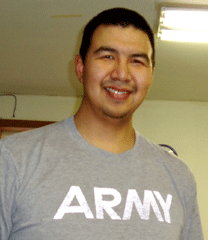
Brice Eningowuk provides technical support to the Shishmaref Erosion and Relocation Committee. (Courtesy of Brice Eningowuk)
ENINGOWUK: Pretty close to six hundred people.
CURWOOD: Where do they live with all those houses falling into the water? You’re on a small island.
ENINGOWUK: There’s a 143 homes in Shishmaref. About 126 are occupied. So each house has about two or three families in one house, in a two to four bedroom house.
CURWOOD: That’s a crowd.
ENINGOWUK: Oh yeah. We’re just one big family here, so.
CURWOOD: Back in 2004, Brice, when Gabe Spitzer did his story, there was a lot of talk about moving your whole community to another location. What’s happened to that suggestion, to that plan?
ENINGOWUK: Well, since 2006 we have been researching an area called Tin Creek. Right now we’re waiting on that final report, and that should be out some time in May. Now, when I heard that little clip you had, that was a discussion about moving to another community, not moving to another location. Like moving to Nome, or moving to Kotzebue. We don’t want to do that. That’s not what we want to do. What we want to do is move to our own land here. Not going into someone else’s lands and trying to occupy that.
CURWOOD: Now, what’s the mood like in town? How do people feel about Shishmaref and its prospects?
ENINGOWUK: In terms of the relocation, I keep getting asked, when are we gonna move, are we gonna move here pretty soon? And right now we’re trying to find a site.
CURWOOD: What are your hopes for your grandchildren, Brice?
ENINGOWUK: I just hope that they have the chance to learn what I’ve learned from my grandparents. Telling somebody how we used to live is different from actually living the way we used to live. I could tell you how it is to be out on the ocean, hunting oogruk, or I could tell you how it is to be out in the country, but if you don’t experience it, it doesn’t affect you as it’s affected me. I just hope that when I have grandchildren, I have the option to teach them what I’ve learned, know our culture, know our way of life.
CURWOOD: Brice Eningowuk has been speaking to us from Shishmaref, Alaska. Thank you so much, sir.
ENINGOWUK: Oh, you’re welcome.
CURWOOD: Brice Eningowuk delivers technical support to Shishmaref's Erosion and Relocation Coalition – and struggles with the phone lines there.
Related link:
Shishmaref Erosion and Relocation Committee
Forecasting A Warmer World
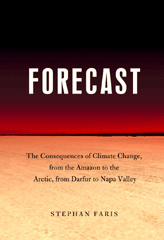
CURWOOD: Probably what comes most immediately to mind when people talk about climate change is melting ice. But maybe we should also consider - the taste of wine and genocide.
It turns out our changing climate is shaping our present and future in mysterious and diverse ways. To flesh out some consequences of climate disruption, author Stephan Faris traveled the world to bring us a forecast – in his new book called "Forecast: The Consequences of Climate Change, from the Amazon to the Arctic, from Darfur to Napa Valley."
Stephan Faris says linking the dots from climate change to the conflict and refugees in Darfur was illustrated vividly in a tale he heard from a doctoral student called Alex de Waal.
FARIS: This doctoral candidate named Alex de Waal came across this Arab sheik, who was kind of a big man in that region, and he invited him into his tent. And he actually draws a picture in the sand like a chessboard, and he says, the black tiles are where the African farmers are, and the white tiles are where are our people are, where the nomadic herders are. And we basically coexist, we’re like chessboard bishops: we cross these places in diagonals. And the land in a sense is serving two people. But that’s no longer working. Alex later on called this the moral geography of the region.
Up until the 1960s and 70s the farmers would plant their crops and the nomads would pass through. They’d graze their camels on the hillsides behind the crops, the farmers would allow them to use their wells, they’d feed the animals with the leavings from the harvest, and you had this kind of symbiotic and peaceful relationship.
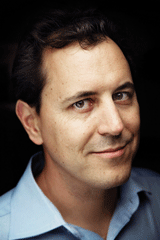
Author Stephan Faris.
And about two decades later, when the violence that we’ve all heard about was breaking out, Alex remembered this story, because he saw that the leader of the Janjaweed, a man named Musa Hilal, was leading these campaigns of ethnic cleansing. And he realized that Musa Hilal was the son of the sheik that he’d met before, the sheik that was fearing about the future of Darfur.
CURWOOD: Basically, the thesis of your book is that climate disruption is just putting pressure on a lot of difficult places on the planet and already making life quite difficult, and I guess it’s only gonna get worse.
FARIS: Sure. And it was a way to look at climate change that had always seemed to me as very abstract, something about melting glaciers or drowning polar bears, or the most relevant it is to me is maybe something like hundreds of years in the future, when Florida’s underwater. But what struck me about Darfur, and what motivated me to keep on doing the research in this book, was that the effects are happening already. Our climate is changing; it’s changing in ways that we’ve never seen it before as a civilization. And every one of those changes is going to be disruptive. Even if places like Darfur and or like Hurricane Katrina we can’t definitively tie them to the emissions of our cars and our factories and our power plants, the fact that these types of effects are the type of effects that we’re expecting to see gives us a glimpse into the future.
CURWOOD: Now, of course, looking at your book, climate is part of everything it seems, and over the near term there are, I gather, some positive effects from warming climate, some of which I think impact wine. How’s that?
FARIS: Well, if you think about what makes a good wine, you’ve got basically three elements. You have the variety of the grape, which is the Merlot or the Cabernet. You have the soil, in which you plant it. And then you have the climate, the weather, the year that it was grown. And so there’s actually a scientist in Oregon, named Gregory Jones, who’s tried to go through the whole world and understand how wine has played out. And he’s looked at different regions from 1950 to 1990, and he’s found that, on average, his temperatures increased about a degree Fahrenheit in those regions. And then he looked at the scale of quality given by auction houses, and he says, that a degree rise in Celsius would lead to about a thirteen point rise on a hundred point scale in quality. And so, so far, climate change has actually benefited wine.
But as temperatures continue to increase, and generally that’s what they’re going to be doing, the wines are going to start getting worse and worse, the grapes are going to start ripening too early on the vine. The year 2003 in Europe was a terrible year for wines because it was so hot that people were picking in August, they had never picked so early before, they were actually hiring refrigerated trucks to keep the grapes in. And one of the wine critics I’ve spoken to kind of describes the wine there as being raisiny and she’s worried that the quality’s going to degrade very quickly with time.

CURWOOD: Now, Stephan, of course these changes that you describe in your book assume only a moderate change in temperature. So, what do you forecast for the world if we see the more dramatic temperature increases that science is talking more and more about?
FARIS: What worries me the most is that everything I covered in my book, which covers potential conflicts in South Asia, it covers immigration pressures, it covers the changing patterns of agriculture – is all stuff that we’re going to experience almost no matter what. None of the proposals in Washington or in Brussels or people who are speaking about replacing the Kyoto protocol are really talking about capping climate change at anything less than about two degrees Celsius, which is about three and a half degrees Fahrenheit. The potential is that we could have you know four or even six degrees Celsius of warming, which is about 11 degrees Fahrenheit, and that’s about the same level of magnitude difference as we had between now and the last ice age. And so the question is what happens next.
CURWOOD: Stephan Faris is the climate change correspondent for GlobalPost.com and the author of the new book "Forecast: The Consequences of Climate Change, from the Amazon to the Arctic, from Darfur to Napa Valley."
Related link:
For more about Stephan Faris, click here
[MUSIC: Nels Cline “Prayer Wheel” from Coward (Cryptogramophone 2009)]
Spring Awakening
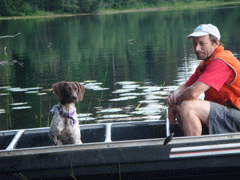
Author Rick Bass and his dog, Auna.
CURWOOD: Where writer Rick Bass lives in the Yaak Valley of Northwest Montana there is a point in the spring when sleep gives way to rambunctious wakefulness, where winter has truly left and won’t be coming back for many months.
BASS: The snow is melting. The grizzly bears that have been sleeping beneath the snow, suspended like seeds, will prowl the warm fields just beneath the snow, grazing on the delicious emerging lilies. Sometimes the yellow pollen gets caught on the fur and snouts of the great golden bears as they grub and push through the lily fields, pollinating other lilies in this manner. In this crude fashion, they are farmers of a kind, nurturing and expanding one of the crops that first meets them each year. The lilies follow the snow, and the snow pulls back to reveal the bears, and the bears follow the lilies. The script of life begins moving with enthusiasm once again, a script and a story more exuberant than any that has been seen so far this year.
And on winter’s remnant glistening ice shields, which grow smaller every day, the grizzly mothers with their cubs slide down the slopes on their backs. They ride the ice to the bottom, cartwheeling into fields of lilies, resting at the bottom of the vanishing glacier, and then climb right back up to the top. They slide and play for hours at a time, safely distanced from the new and changing world that lies along the river bottoms and in the lower elevations where people live. There is nothing but joy and new wakefulness running through their blood.

Author Rick Bass and his dog, Auna.
CURWOOD: Rick Bass lives and writes in the Yaak valley, in Montana. This snapshot of bears and lilies at the end of winter comes from his forthcoming book, The Wild Marsh.
[MUSIC: Jenny Scheinman “Awful Sad from Crossing The Field (Koch records 2008)]
CURWOOD: Living on Earth is produced by the World Media Foundation. Our crew includes Ashley Ahearn, Bobby Bascomb, Eileen Bolinsky, Bruce Gellerman, Ingrid Lobet, Helen Palmer, Ike Sriskandarajah, Mitra Taj and Jeff Young, with help from Sarah Calkins and Marilyn Govoni. Special thanks this week to the Alaska Humanities Forum for its support of our story from Shismaref. Also this week, we bid a very fond farewell to our awesome producer Ashley Ahearn, and wish her happy trails. Our interns are Lindsay Breslau, Liz Gross, Phil DiMartino and Christine Parrish. Jeff Turton is our technical director. Alison Lirish Dean composed our themes. You can find us anytime at LOE dot org. I’m Steve Curwood. Thanks for listening.
ANNOUNCER: Funding for Living on Earth comes from the National Science Foundation, supporting coverage of emerging science. And Stonyfield farm, organic yogurt and smoothies. Stonyfield pays its farmers not to use artificial growth hormones on their cows. Details at Stonyfield.com. Support also comes from you, our listeners. The Ford Foundation, the Town Creek Foundation, The Oak Foundation, supporting coverage of climate change and marine issues. The Skoll Foundation, supporting social entrepreneurs around the world, uncommon heroes dedicated to the common good. Learn more at skoll.org. And Pax World Mutual Funds, socially and environmentally sustainable investing. Pax World for tomorrow. On the web at Paxworld.com.
ANNOUNCER 2: PRI Public Radio International.
Related links:
- For more on Rick Bass, click here
- Rick Bass’ Collection
Living on Earth wants to hear from you!
Living on Earth
62 Calef Highway, Suite 212
Lee, NH 03861
Telephone: 617-287-4121
E-mail: comments@loe.org
Newsletter [Click here]
Donate to Living on Earth!
Living on Earth is an independent media program and relies entirely on contributions from listeners and institutions supporting public service. Please donate now to preserve an independent environmental voice.
NewsletterLiving on Earth offers a weekly delivery of the show's rundown to your mailbox. Sign up for our newsletter today!
 Sailors For The Sea: Be the change you want to sea.
Sailors For The Sea: Be the change you want to sea.
 Creating positive outcomes for future generations.
Creating positive outcomes for future generations.
 Innovating to make the world a better, more sustainable place to live. Listen to the race to 9 billion
Innovating to make the world a better, more sustainable place to live. Listen to the race to 9 billion
 The Grantham Foundation for the Protection of the Environment: Committed to protecting and improving the health of the global environment.
The Grantham Foundation for the Protection of the Environment: Committed to protecting and improving the health of the global environment.
 Contribute to Living on Earth and receive, as our gift to you, an archival print of one of Mark Seth Lender's extraordinary wildlife photographs. Follow the link to see Mark's current collection of photographs.
Contribute to Living on Earth and receive, as our gift to you, an archival print of one of Mark Seth Lender's extraordinary wildlife photographs. Follow the link to see Mark's current collection of photographs.
 Buy a signed copy of Mark Seth Lender's book Smeagull the Seagull & support Living on Earth
Buy a signed copy of Mark Seth Lender's book Smeagull the Seagull & support Living on Earth

